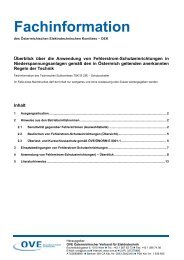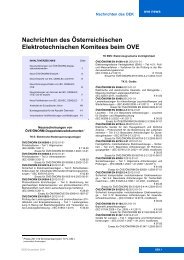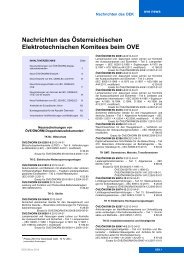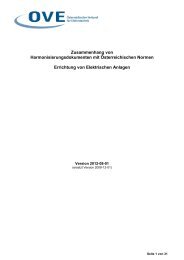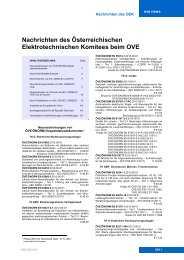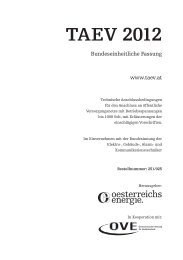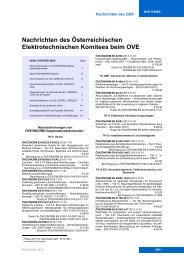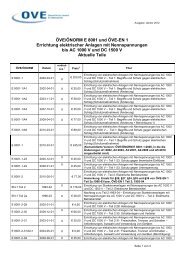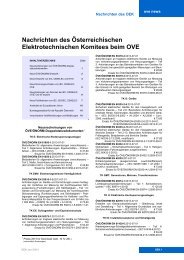Primer on Standards - OEK - OVE
Primer on Standards - OEK - OVE
Primer on Standards - OEK - OVE
- No tags were found...
You also want an ePaper? Increase the reach of your titles
YUMPU automatically turns print PDFs into web optimized ePapers that Google loves.
Introducti<strong>on</strong>This primer is intended as a basic introducti<strong>on</strong> to the influential, challenging andyet relatively unknown world of electrotechnical standardizati<strong>on</strong>. Whether youstudy or teach, work in a small family business, a law firm, or a multinati<strong>on</strong>al,whether you manufacture, market or simply use electrotechnical products, thisguide will provide answers to your most comm<strong>on</strong> questi<strong>on</strong>s. It will also give youa closer look at CENELEC, the European Committee for Electrotechnical Standardizati<strong>on</strong>,the main topic of this booklet.Although at first the term standardizati<strong>on</strong> may summ<strong>on</strong> images of a facelessBrave New World where everything is the same shape and size, nothing is furtherfrom the truth! Standardizati<strong>on</strong> is actually a highly efficient way to achievemobility through compatibility, and quality through market-driven needs. <strong>Standards</strong>,in fact, are so much a part of our lives that we no l<strong>on</strong>ger even notice they arearound - until something happens to show how vital they really are.Even though standardizati<strong>on</strong>'s most pressing goal is undoubtedly to ensure safety,it also facilitates commerce and eases communicati<strong>on</strong>. European standardizati<strong>on</strong>,as we will see throughout this booklet, fosters ec<strong>on</strong>omic exchanges when aproduct c<strong>on</strong>forming to the standards of <strong>on</strong>e European country is granted accessto all of CENELEC 22 member countries because CENELEC standards are identicalfrom Portugal to Finland, from Malta to Iceland.In our increasingly global world, acquaintance with standards has grown <strong>on</strong> themanufacturer’s side in their need to refer to them when they place their goods<strong>on</strong> the European market. However am<strong>on</strong>g c<strong>on</strong>sumers and others not directlyinvolved in manufacturing, the general rule is still lack of awareness, misc<strong>on</strong>cepti<strong>on</strong>sand c<strong>on</strong>fusi<strong>on</strong>. This is quite understandable, though, as standards are highlycomplex animals with numbered references, multiple amendments, and regularupdates to keep pace with technology. This is why we have included a chapterin this guide that explains basically just what a standard is, the different kindsof standards, why they should be applied by industries and the advantages forc<strong>on</strong>sumers.Throughout the world, standardizati<strong>on</strong> in each country or regi<strong>on</strong> is flavoured byits specific historical, ec<strong>on</strong>omic and cultural c<strong>on</strong>text. Many of Europe's best recipesare the product of co-operati<strong>on</strong> between European legislati<strong>on</strong> and standardizers.The process has a terminology of its own, and it is not easy to grasp c<strong>on</strong>ceptssuch as harm<strong>on</strong>ized standards, New Approach Directives, and presumpti<strong>on</strong> ofc<strong>on</strong>formity, learn know standards are developed and to which products they apply,or comprehend their relati<strong>on</strong>ship with European Legislati<strong>on</strong>. This guide will tryto clarify these and other questi<strong>on</strong>s as simply as possible.4 CENELEC. <str<strong>on</strong>g>Primer</str<strong>on</strong>g> <strong>on</strong> <strong>Standards</strong>




